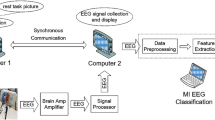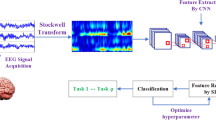Abstract
Same limb motor imagery (MI) brain-computer interfaces can effectively overcome the cognitive disassociation problem of the traditional different-limb MI paradigm, and they can reduce the patient burden and extend the functionality of external devices more effectively. However, the electroencephalogram (EEG) MI features of same limb originate from one side of the brain, which poses a great challenge to MI EEG feature mining and selection as well as accurate decoding. To overcome this problem, we propose an adaptive feature selection strategy for subject-specific optimal frequency band based on regularized common spatial pattern (RCSP) and stepwise discriminant analysis, then combine the integrated classification strategy to accurately decode three types of single-limb MI tasks. As there are minor frequency band differences and huge variability for the same limb MI tasks, RCSP was used to extract spatial distribution features, which reduced the influence of the length of the time window and differences of the frequency bands, and then the optimal frequency band range for each subject was selected by stepwise discriminant analysis. Furthermore, an integrated classification strategy based on multiple efficient classifiers is used for MI accurate recognition. The proposed method obtains 76.58% accuracy in the unilateral limb MI recognition task, which is 12.67%, 9.89%, 6.62%, and 7.90% higher than other traditional decoding methods such as CSP + LDA, FBCSP + LDA, FBCSP + C2CM, and FBCSP + SVM, respectively. Compared with Deep ConvNet and EEGNet, the decoding accuracy is improved by 16.93% and 7.33%, respectively. The experimental results show that our proposed highly efficient method improves the decoding accuracy for classifying different joints of unilateral limbs and has high promotion and application value.











Similar content being viewed by others
Data availability
The datasets discussed in the manuscript are publicly available for research purposes.
References
Wolpaw, J.R., et al.: Brain-computer interface technology: a review of the first international meeting. IEEE Trans. Rehabilit. Eng. 8(2), 64–173 (2000)
Risoli, A., et al.: A new gaze-BCI-driven control of an upper limb exoskeleton for rehabilitation in real-world tasks. IEEE Trans. Syst. Man. Cybern. C 42(6), 1169–1179 (2012)
Choi, Kyuwan, and Andrzej Cichocki. "Control of a wheelchair by motor imagery in real time. Intelligent Data Engineering and Automated Learning–IDEAL 2008: 9th International Conference Daejeon, South Korea, November 2-5, 2008 Proceedings 9. Springer Berlin Heidelberg, 2008.
Edelman, B.J., Baxter, B., He, B.: EEG source imaging enhances the decoding of complex right-hand motor imagery tasks. IEEE Trans. Biomed. Eng. 63(1), 4–14 (2015)
Padfield, N., et al.: EEG-based brain-computer interfaces using motor-imagery: techniques and challenges. Sensors 19(6), 1423 (2019)
Xie, J., et al.: Robust autoregression with exogenous input model for system identification and predicting. Electronics 10(6), 755 (2021)
Rodríguez-Bermúdez, G., García-Laencina, P.J.: Automatic and adaptive classification of electroencephalographic signals for brain computer interfaces. J. Med. Syst. 36, 51–63 (2012)
Khan, J., et al.: Multiclass EEG motor-imagery classification with sub-band common spatial patterns. EURASIP J. Wireless Commun. Netw. 2019, 1–9 (2019)
Friedman, J.H.: Regularized discriminant analysis. J. Am. Stat. Assoc. 84(405), 165–175 (1989)
Varsehi, H., Mohammad, S., Firoozabadi, P.: An EEG channel selection method for motor imagery based brain–computer interface and neurofeedback using granger causality. Neural Netw. 133, 193–206 (2021)
Zhou, X., Zou, R., Huang, X.: Single upper limb functional movements decoding from motor imagery EEG signals using wavelet neural network. Biomed. Signal Process. Control 70, 102965 (2021)
Ma, X., Qiu, S., He, H.: Multi-channel EEG recording during motor imagery of different joints from the same limb. Sci. Data 7(1), 191 (2020)
Ma, X., et al.: A temporal dependency learning CNN with attention mechanism for MI-EEG decoding. IEEE Trans. Neural Syst. Rehabilit. Eng. (2023). https://doi.org/10.1109/TNSRE.2023.3299355
Han, J., Wei, X., Aldo Faisal, A.: EEG decoding for datasets with heterogenous electrode configurations using transfer learning graph neural networks. J. Neural Eng. 20(6), 066027 (2023)
Yang, L., et al.: A novel motor imagery EEG decoding method based on feature separation. J. Neural Eng. 18(3), 036022 (2021)
Wang, J., Yao, L., Wang, Y.: IFNet: an interactive frequency convolutional neural network for enhancing motor imagery decoding from EEG. IEEE Trans. Neural Syst. Rehabilit. Eng. 31, 1900–1911 (2023)
Liu, Ke., et al.: FBMSNet: a filter-bank multi-scale convolutional neural network for EEG-based motor imagery decoding. IEEE Trans. Biomed. Eng. 70(2), 436–445 (2022)
Yang, L., et al.: Motor imagery EEG decoding method based on a discriminative feature learning strategy. IEEE Trans. Neural Syst. Rehabilit. Eng. 29, 368–379 (2021)
Song, Yonghao, et al. "Transformer-based spatial-temporal feature learning for EEG decoding." arXiv preprint arXiv:2106.11170 (2021).
Mane, Ravikiran, et al. "FBCNet: A multi-view convolutional neural network for brain-computer interface. arXiv preprint arXiv:2104.01233 (2021).
Ma, X., Qiu, S., He, H.: Time-distributed attention network for EEG-based motor imagery decoding from the same limb. IEEE Trans. Neural Syst. Rehabilit. Eng. 30, 496–508 (2022)
Ramu, V., Lakshminarayanan, K.: Enhanced motor imagery of digits within the same hand via vibrotactile stimulation. Front. Neurosci. 17, 1152563 (2023)
Bashivan, Pouya, et al. "Learning representations from EEG with deep recurrent-convolutional neural networks." arXiv preprint arXiv:1511.06448 (2015).
Saeidi, M., Karwowski, W., Farahani, F.V., Fiok, K., Taiar, R., Hancock, P.A., Al-Juaid, A.: Neural decoding of EEG signals with machine learning: a systematic review. BrainSciences 11(11), 1525 (2021)
Li, Huaqing, Feihu Qi, and Shaoyu Wang. "A comparison of model selection methods for multi-class support vector machines." International Conference on Computational Science and Its Applications. Berlin, Heidelberg: Springer Berlin Heidelberg, 2005.
Arjona, C., et al.: Evaluation of LDA ensembles classifiers for brain computer interface. J. Phys. Conference Series. 332, 012025 (2011)
Dai, M., et al.: Domain transfer multiple kernel boosting for classification of EEG motor imagery signals. IEEE Access 7, 49951–49960 (2019)
Chatterjee, S., Byun, Y.-C.: EEG-based emotion classification using stacking ensemble approach. Sensors 22(21), 8550 (2022)
Padfield, N., et al.: Multi-segment majority voting decision fusion for MI EEG brain-computer interfacing. Cognitive Comput. 13, 1484–1495 (2021)
Ramoser, H., Muller-Gerking, J., Pfurtscheller, G.: Optimal spatial filtering of single trial EEG during imagined hand movement. IEEE Trans. Rehabilit. Eng. 8(4), 441–446 (2000)
Jiang, J., et al.: Temporal combination pattern optimization based on feature selection method for motor imagery BCIs. Front. Human Neurosci. 14, 231 (2020)
Gaur, P., et al.: A sliding window common spatial pattern for enhancing motor imagery classification in EEG-BCI. IEEE Trans. Instrum. Meas. 70, 1–9 (2021)
Karácsony, Tamás, et al. "Brain computer interface for neuro-rehabilitation with deep learning classification and virtual reality feedback." Proceedings of the 10th Augmented Human International Conference 2019. 2019.
Duda, Richard O., and Peter E. Hart. Pattern classification. John Wiley & Sons, 2006.
Hori, Junichi, and Rei Akagawa. "Improvement in Classification of Tactile Event-Related Potentials using Random-Interval Tasks." 2018 40th Annual International Conference of the IEEE Engineering in Medicine and Biology Society (EMBC). IEEE, 2018.
Rakibul, M.M., et al.: A comparison of classification techniques to predict brain-computer interfaces accuracy using classifier-based latency estimation. Brain Sci. 10(10), 734 (2020)
Floriano, A., et al.: Assessment of high-frequency steady-state visual evoked potentials from below-the-hairline areas for a brain-computer interface based on depth-of-field. Comput. Methods Progr. Biomed. 184, 105271 (2020)
Aldea, Roxana, Monica Fira, and Anca Lazăr. "Classifications of motor imagery tasks using k-nearest neighbors." 12th Symposium on Neural Network Applications in Electrical Engineering (NEUREL). IEEE, 2014.
Chen, Chih-Yu, et al. "A novel classification method for motor imagery based on Brain-Computer Interface." 2014 International Joint Conference on Neural Networks (IJCNN). IEEE, 2014.
Park, C., Took, C.C., Mandic, D.P.: Augmented complex common spatial patterns for classification of noncircular EEG from motor imagery tasks. IEEE Trans. Neural Syst. Rehabilit Eng. 22(1), 1–10 (2013)
Tyagi, A., Nehra, V.: Classification of motor imagery EEG signals using SVM, k-NN and ANN. CSI Trans. ICT 4(2), 135–139 (2016)
Aggarwal, S., Chugh, N.: Review of machine learning techniques for EEG based brain computer interface. Archi. Comput. Methods Eng. 29(5), 3001–3020 (2022)
Jeong, J.-H., et al.: Multimodal signal dataset for 11 intuitive movement tasks from single upper extremity during multiple recording sessions. GigaScience 9(10), giaa098 (2020)
Tao, Z., et al.: A method for identifying vesicle transport proteins based on LibSVM and MRMD. Comput. Math. Methods Med. 2020(1), 8926750 (2020)
Zhang, R., et al.: Recognition of single upper limb motor imagery tasks from EEG using multi-branch fusion convolutional neural network. Front. Neurosci. 17, 1129049 (2023)
Ma, X.L., Qiu, S., Wei, W., et al.: Deep channel-correlation network for motor imagery decoding from same limb. IEEE Trans. Neural Syst. Rehabil. Eng. 28(1), 297–306 (2020)
Ang, Kai Keng, et al. "Filter bank common spatial pattern (FBCSP) in brain-computer interface." 2008 IEEE international joint conference on neural networks (IEEE world congress on computational intelligence). IEEE, 2008.
Sakhavi, S., Guan, C., Yan, S.: Learning temporal information for brain-computer interface using convolutional neural networks. IEEE Trans. Neural Netw. Learn. Syst. 29(11), 5619–5629 (2018)
Schirrmeister, R.T., et al.: Deep learning with convolutional neural networks for EEG decoding and visualization. Human Brain Map 38(11), 5391–5420 (2017)
Lawhern, V.J., et al.: EEGNet: a compact convolutional neural network for EEG-based brain–computer interfaces. J. Neural Eng. 15(5), 056013 (2018)
Funding
This work was supported by the National Natural Science Foundation of China [No.62476255 and No. 62303427], the Young Teacher Foundation of Henan Province [No.2021GGJS093], the Key Science and Technology Program of Henan Province [No.242102211058 and No.242102211018], the Key Science Research Project of Colleges and Universities in Henan Province of China [No.25A520003], and the Young Backbone Teacher Program of Zhengzhou University of Light Industry.
Author information
Authors and Affiliations
Contributions
Yinghui Meng: Conceptualization, Methodology and Validation Nuo Zhu: Formal analysis, Investigation and Writing-Original Draft Duan Li:Writing-Review and Editing Jiaofen Nan: Supervision Yongquan Xia: Data Curation Ni Yao: Resources Chuang Han Supervison.
Corresponding author
Ethics declarations
Competing Interests
The authors declare that they have no conflict of interest.
Additional information
Publisher's Note
Springer Nature remains neutral with regard to jurisdictional claims in published maps and institutional affiliations.
Rights and permissions
Springer Nature or its licensor (e.g. a society or other partner) holds exclusive rights to this article under a publishing agreement with the author(s) or other rightsholder(s); author self-archiving of the accepted manuscript version of this article is solely governed by the terms of such publishing agreement and applicable law.
About this article
Cite this article
Meng, Y., Zhu, N., Li, D. et al. Stepwise discriminant analysis based optimal frequency band selection and ensemble learning for same limb MI recognition. Cluster Comput 28, 197 (2025). https://doi.org/10.1007/s10586-024-04818-4
Received:
Revised:
Accepted:
Published:
DOI: https://doi.org/10.1007/s10586-024-04818-4




